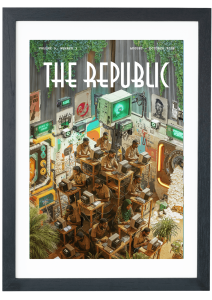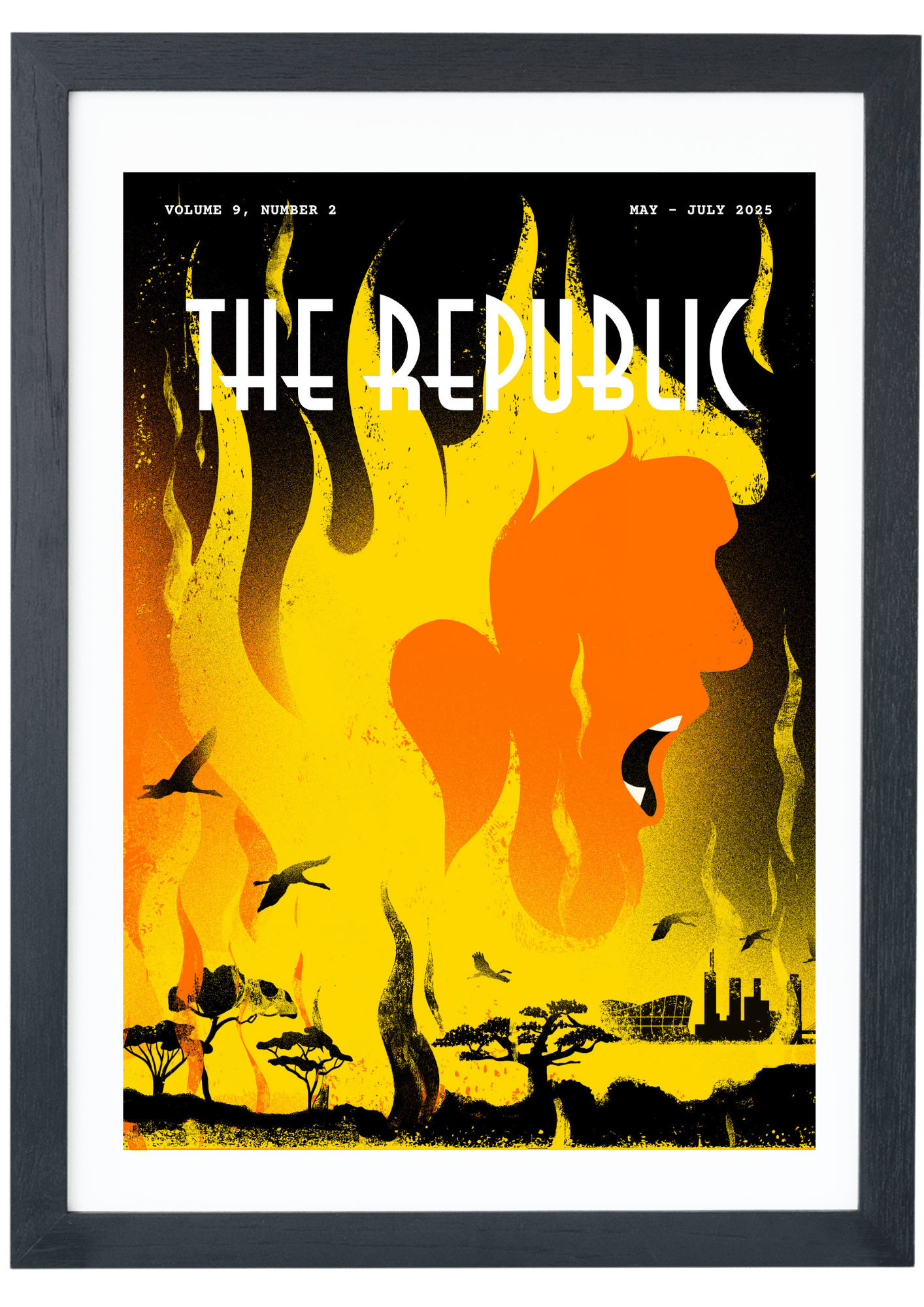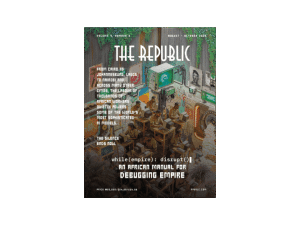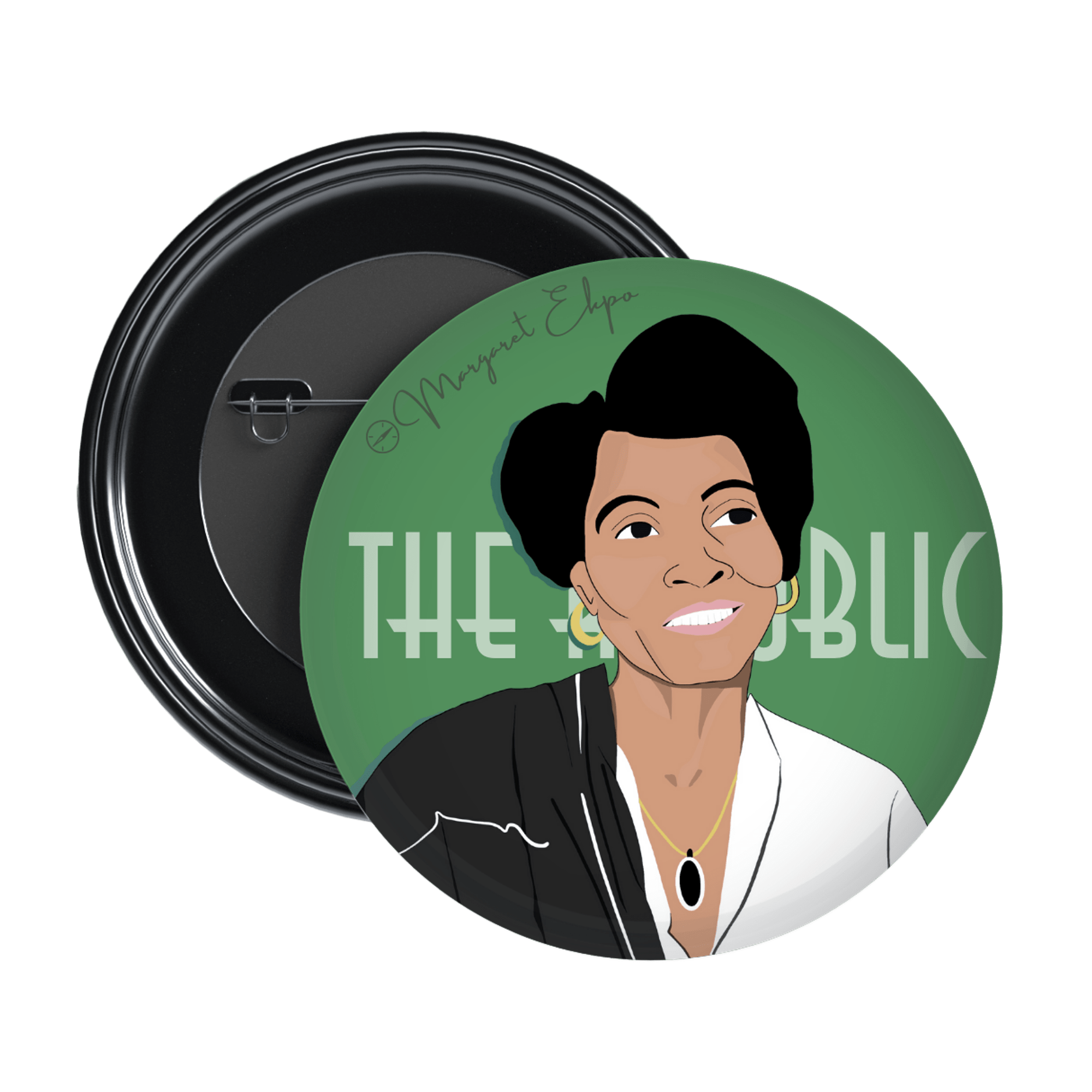
Photo Illustration by Ezinne Osueke / THE REPUBLIC. Source Ref: WIKIMEDIA.
THE MINISTRY OF MEMORIES
Nok and Africa’s Disregard for Prehistory

Photo Illustration by Ezinne Osueke / THE REPUBLIC. Source Ref: WIKIMEDIA.
THE MINISTRY OF MEMORIES
Nok and Africa’s Disregard for Prehistory
Under a gentle beam of white light, two figureheads of fired clay glare in apprehension. They are posed behind a glass pane inside the Yemisi Shyllon Museum in Lekki, Lagos. Through the hollow pupils of their triangular eyes, they gawk at me, the evening visitor pretending to have survived more stress in under twelve hours than they have in the last 2,000 years. It is a sunny Tuesday in the middle of September, 2024. Propelled by curiosity, I have flown all the way from Port Harcourt to Lagos. My work as a history writer has seen me spend the last year collecting and reorganizing Nok history resources. The project is in its final stages, and this journey is a step in offloading a persistent burden regarding two elusive Nok heads. The two historic art pieces have roamed the highbrow streets of the global art world for the past three decades. I have come to check if they are here now, in this recently opened museum that boasts of two authentic and recently retrieved original Nok artefacts. I will put up at a cousin’s house in Ikorodu for the night. For now, I have braved the onset of Lagos’s rush hour to be at Pan Atlantic University, where the museum, an architectural masterwork, sits.
After a strenuous walk from the external gate of the compound, there are only 15 minutes left until 4 p.m., when the museum closes its doors. But the lights will stay on for up to 30 more minutes, because I have come such a long way, the front desk officer had informed me. I suspect, instead, that it has more to do with me being one of the very small crop of visitors they’ve hosted for the day. However, I have arrived so late, I am told, that I cannot expect the privilege of a guide, which is just as well. I have spent sufficient time learning about Nok that what matters to me is seeing the heads for myself and relishing the essence of their spiritual presence. Both pieces of terracotta are intricately stylized and crafted with acutely proportionate dimensions. Their aesthetic magnificence is owed to the workmanship of the Nok artists from a civilization over 2,500 years old. By observing them, I cannot but see how they represent a definitive strain of what should otherwise be taught as classical African art. A part of what distinguishes Nok art is that it flourished remotely and on an enduring timescale, such that ancient art heavyweights like Greece were yet to realize.
Though the Nok civilization was brought to light in 1943, it was not so named until years later. Written history notes Britain’s Bernard Fagg as its discoverer. His house, palatial in the context of a twentieth-century Nok village in the Jaba Local Government Area of Kaduna State, is now a museum piece, sitting on a distinct rock formation. It overlooks a tin mining basin, and it was during operations in this basin that the phenom of the Nok heads began to be unearthed. The heads would make their debut in the international antiquity market decades later. Unfortunately, around the turn of the millennium, the racketeering of Nok terracotta had become a feature of this market. Despite their scarcity, stolen pieces traded hands faster than could be tracked. While Nigeria stood dazed (or not) at this global pillaging, two authentic pieces slipped within the sights of Jacques Chirac, France’s national president from 1995 to 2007. When Nigeria signalled for their return, Chirac refused to acquiesce. Instead, both pieces were given spots behind glass boxes in Paris’s popular Louvre Museum.
It is alleged that Nigeria’s then president, Olusegun Obasanjo, reached a deal over the phone with his French counterpart. No one in the public sphere understood what this deal portended for Nigeria beyond a ‘recognition’, but what it clearly revealed was that France would hold on to our art for a renewable set of 25 years. In other words, whatever potential the French saw in Nok art eluded Nigeria. It is worth knowing that before Chirac got his hands on them, both items of Nok terracotta existed on the International Council of Museums’ red list, as art prohibited from any form of exportation. They could not have left Nigeria legally. Obasanjo’s purported agreement, therefore, was a ratification of an internationally recognized crime. On one hand, it emboldened looters. On the other, it dampened the spirits of many actors, locally and internationally, who invested themselves in the preservation of Nigeria’s cultural heritage.
The late Folarin Shyllon (no known relation to the Yemisi Shyllon Museum), a renowned antiquity law professor, had referred to this Nigerian–French agreement as an ‘unrighteous conclusion.’ He described Nigeria’s federal government as weak and completely lacking in national pride. This unrighteous exchange between presidents took place in 1999, as is known, and 2024 marked the beginning of the deal’s expiration. I present this quandary as a question to the guide at the museum when he slips into the hallway. He tells me that their Nok pieces had not come by way of France. To be candid, I had not thought that they did.
A HISTORY HIJACKED
From Ajah motor park, where I boarded the vehicle for Ibeju-Lekki, and for the ensuing 20 minutes, I ceded control to Google Maps.
‘So where are we now?’ the driver leaned in to ask. He had noticed me looking up intermittently from my phone at the street signs and business boards.
I pointed at the pulsating blue dot creeping lazily across the phone screen. ‘See us here.’
He straightened. There was a brief pause during which the gleeful disposition of his face disappeared into an introspective one. ‘Kai! Oyibo!’ he cried.
Despite the breeze pouring in on my face from the window, I felt the heat of annoyance rise in me. I could not alight at Yemisi Shyllon soon enough. Discomfiting as it was, the driver’s comment was only a vocalization of the average African’s disposition to African intellectuality in comparison to that of other races. There is a persistent inability of the ordinary African to reconcile themselves with an ardent enquiry into raw, ingenious knowledge. This driver had exclaimed not at the impeccable utility of the app but, in contrast, at his certainty in his own ‘genetically-coded’ incapability to have masterminded it. Going hand in hand with this crisis is the erosion of a history of intellectuality through decades of brazen imperialist manipulation of historical resources.
Chief Beno Adamu, the district head of Nok town, had presented a case for this thought a few days earlier. It was the mid-hour of a wet Sunday in September 2024, and I’d visited his Nok residence in Kaduna. ‘They say that Fagg discovered [these terracotta], but these things have always been used here.’ He leaned back in his chair to cross his legs. ‘Now they [foreigners] are the Nok experts, making a hell of money, while we are here. You see what our village looks like.’ The chief’s house sits in the centre of a neat compound, fenced from the squalor of the surrounding houses. Around the veranda, where we held the conversation, his kinsmen ambled about, our discussion punctuated by the errands he sent and received. Propped in an armless plastic chair before him, I saw how the situation could be reminiscent of Mungo Park’s River Niger discovery. Though the Mungo Park misattribution has been revisited and debunked by a smattering of modern literature as only another Western-centred worldview, as Ezenwa Olumba writes in The Republic, this counterclaim is yet to find any coherent expression in mainstream academia.
What is expressed instead is a dearth of interest in our pre-colonial history; an almost consensual neglect. The archival threads of our formation have stayed unnoticed and unwoven, such that the fabric from which socio-cultural progress is sewn remains immaterial. This gap is what gives ample room for international exploitation, as well as what many may refer to as cultural imperialism. If the taxi driver I had talked to, therefore, imbibes the position of the intellectually inferior, he is only a victim of this doubly-handled machinery of foreign exploitation and local neglect.
shop the republic
CULTURING A DECAY
At the National Museum in Kaduna, the resident curator unlocks the rusty padlock to the main building. I step around rat droppings to enter one of two inner rooms. There are banners hanging from the walls, displaying images of clusters of foreign students at various excavation sites in the Nok basin. In some photographs, they squat, hands in the dirt, digging. In other frames, they encircle a professional, receiving an on-site lecture. There are no Black faces in these images. No signs of an African receiving hands-on learning about themselves. This photographed group of teachers and learners is the party of foreigners Chief Beno Adamu had referred to, an expedition from Germany’s Goethe University.
Comprising archaeologists, archeobotanists and other professionals, and led by Professor Peter Breunig, the Germans had occupied the Nok soil from 2005 through 2013. They are equally responsible for most of the authoritative literature on the subject. Where problems stemmed from, however, and what analysts deplored when major excavations began, involved ethical conduct more than it did historical acuity. It was a decade-long controversy, originating around 2007, on the wholesale removal of hundreds of terracotta pieces freshly unearthed in the Nok valley to Frankfurt for ‘repair’. In October of 2013, the artefacts would get a comparative exhibition in Germany for the first time, alongside Egyptian and Grecian works. The exhibition spanned months and confirmed a number of Germans as Nok experts, a situation many African professionals begrudge.
One such professional is Zacharys Anger Gundu, a professor of archaeology, whose job at Ahmadu Bello University, Zaria, linked him with the Germans at the Nok basin. Having witnessed the exercise, Professor Gundu blasted Nigeria’s federal government for handing over to the Europeans a premier opportunity to have sole custody of Nok finds, a situation that could skew the interpretation of the terracotta and reinforce biased European historiographies.
‘I was not a part of it,’ he clarified rather sternly about the excavation. ‘But I was aware of it.’ We were speaking via phone and text for the second time in July 2024. At the time of the excavation, he was president of the Archaeological Association of Nigeria.
It is stale knowledge that Western outfits are more likely to align every tangible bit of African history with a narrative of the primitiveness of African culture. But it ought to be acknowledged that this tendency only takes root in the absence of a convincingly comprehensive output from relevant African institutions. In lieu of this, Gundu berated Nigeria’s National Commission for Museums and Monuments (NCMM) for its mishandling of a strategic heritage resource. He wrote in an August 2020 paper:
Nigeria has continued to show weakness in engaging European countries and museums on the question of returns. [It] is yet to appreciate the fact that antiquities seized can only return through pressure. In the meantime, [it] continues to approve the exhibition of looted materials in Europe.
Kwame Opoku, a Ghanaian cultural commentator, criticized the affair. He decried what he called the stripping of Nok art of its social connections. He considered it a disrespect to assume that Nigeria was incapable of contextualizing its own history. He said:
It is difficult to understand why artefacts newly recovered in Nigeria should be exhibited first in Germany, and not in the country where they were discovered. This raises the question: to whom the Nok pieces are of relevance? Whose history and culture does this new evidence enrich or clarify? Are Nigerians the primarily concerned people? What relevance has the Nok pieces to German history or culture?
To flip Opoku’s concern on its head is to expose an even grittier matter: what relevance did Nigeria’s government place on Nok and the historical significance of its terracotta? Was the NCMM, at any time, disposed towards the task of contextualizing Nok art and establishing Nigeria’s place as West Africa’s foremost hub of civilization? It is disheartening to realize that, amid a vast range of historical and cultural wealth, historical and anthropological research in Nigeria are in want of state attention, financial and otherwise. Archaeology as an academic discipline is mostly disregarded nationwide. Institutions that dare to offer such degrees have had to pair them with some other field to preserve their threadbare relevance.
Professor Gundu refers to this situation as a crisis of confidence. Concerning the absence of a Black face in the picture frames I found inside the National Museum in Kaduna, he had likewise complained:
Since 2005, when the Nok project started, the Germans have trained up to eight postgraduate students of European extraction at the master’s level using the Nok valley as a laboratory. At least two of these have started a PhD programme on different aspects of Nok. Interestingly, no Nigerian has yet been trained from this project at the postgraduate level.
From the highest to the lowest levels of the educational process, there is a glaring institutional disinterest in the histories of the ethnic nationalities that comprise Nigeria. Despite the role history could play in curating an authentic identity for the Nigerian, the basic school curriculum manifests the barest agenda towards deploying this tool. It should be asked—what sources of pride exist for the Nigerian child who is newly inducted into society? How familiar is the average Yoruba child with the Ife bronze works and their artistic novelty to be able to appropriate their ingenuity? What are the chances of finding an Efik schoolgirl from Cross River who knows and understands both the wholeness and transmission styles of the Nsibidi syllabary as a testament to the intellectual past of her forebears? Is it possible to cull two in ten boys from north-east Nigeria who may at least acknowledge the statecraft of the Kanem-Bornu empire, which boasted the most efficient pan-African trade relations in global history?
It would appear that, according to the Nigerian administration, the pursuit of a cohesive national entity requires the obliteration of sacrosanct foundations and identities. Divisive tendencies in a multi-ethnic system can evoke such an unseemly measure, but there are no real benefits to be gained from this. For a vastly multi-cultural society like Nigeria, this is a vain venture, if not a self-harming one. This is because, while Nigeria may be a recent creation, even more recently refreshed at her 1960 independence, the Nigerian themselves is not a recent entity. The Nigerian is a culmination of centuries of specific social transformations, a product long in the making.
shop the republic
A CONTINENT-WIDE NEGLIGENCE
In December 2023, a newly translated ancient manuscript of Ethiopian origin was globally launched from The Deichman Tøyen Library in Norway. Dag Herbjørnsrud, a Norwegian global historian of ideas, had written the preface to the translated document. In a private conversation with me after the event, he lamented the difficulty of finding an Ethiopian scholar interested in the launch of the project. He had evidently overestimated Africa’s interest in reaching for its past.
The Hatata Inquiries, as the work is referred to, is a combination of two books of sixteenth-century Ethiopian philosophy, written purely in Ge’ez by Ethiopian philosophers, Zara Yaqob and his student, Walda Heywat. The work, in which they propound for feminism and argue against slavery, is a stellar addition from East Africa to an otherwise Eurocentric canon of historical philosophical texts.
Over the centuries, the texts have dealt with contrarian views about their authorship. The German orientalist Enno Littmann evoked deeply racist ideas about African capabilities by outrightly declaring that ‘these flowers could not grow solely from Ethiopian ground.’ In a published article, Conti Rossini, another orientalist who prided himself on his knowledge of East Africa, strenuously ascribed their penmanship to the Roman Catholic missionary, Giusto da Urbino. It was only in 2023 that Princeton professor and co-translator of the resurfaced text, Wendy Laura Belcher, led an academic team to prove beyond doubt the Ethiopian origin of its writers. But herewith, despite his contacts with the Addis Ababa’s higher institutions, Mr Herbjørnsrud found it taxing to reintroduce this text to the African scholastic realm.
In a jarring twist, the same Hatata Inquiries, published in November 2023 as a translated text, has been a subject of study at the University of Turin in Italy since May 2024. It also featured on the German publisher De Gruyter’s bestseller list on open philosophy in March 2024. The possible outcome of this in a few years is not hard to conjecture; Ethiopians will be taught their philosophical history by Europeans. In a similar vein, Cameroon displays a grossly incommensurate action against Berlin’s hoard of over 40,000 Cameroonian artefacts. There has been no statement, whether of displeasure or pleasure, traceable to the country’s government in light of the exposure. This laxity appears historical, knowing that neither Cameroon nor the Republic of Chad can locate—or care to anymore—the 2,000-year-old phenom of Sao civilization art. This is despite the knowledge that French professionals, Jean-Paul Lebeuf and Marcel Griaule, once had custody of them at separate times and have produced authoritative literature on them.
Wherever one looks to on the continent, there is a case of a vital and vestigial African past blown away by the winds of cultural imperialism to a location African leaders could not be less bothered to reach; a race gripped in the throes of a plundered past, with the attendant identity crisis. The average African child has been, and continues to be, wrested from the knowledge of their history and the wealth of their origin. To assert bluntly, while Africa is being carved into a specimen for the world to study and become experts in, Africa flounders in ignorance of itself, unable and unwilling to actively participate in the framing of its character. It is not a surprise that most of what the world, Africa included, knows about the continent is what the rest of the world says of it.
shop the republic
-
‘The Empire Hacks Back’ by Olalekan Jeyifous by Olalekan Jeyifous
₦70,000.00 – ₦75,000.00Price range: ₦70,000.00 through ₦75,000.00 This product has multiple variants. The options may be chosen on the product page -
‘Make the World Burn Again’ by Edel Rodriguez by Edel Rodriguez
₦70,000.00 – ₦75,000.00Price range: ₦70,000.00 through ₦75,000.00 This product has multiple variants. The options may be chosen on the product page -
‘Nigerian Theatre’ Print by Shalom Ojo
₦150,000.00 -
‘Natural Synthesis’ Print by Diana Ejaita
₦70,000.00 – ₦75,000.00Price range: ₦70,000.00 through ₦75,000.00 This product has multiple variants. The options may be chosen on the product page
shop the republic
RETURNING TO / RETURNING THE FUTURE
The traffic jam from Victoria Island to Lagos’ mainland is so dense, the word ‘traffic’ trends all night on Nigerian X (formerly known as Twitter). The clouds roar above, and the bench at the back of the bus, where I am sitting, is unwilling to accommodate a sleepy passenger; I find myself groggy and dreaming of a cousin’s bed that I have never seen. As soon as we break out of the gridlock, the clouds burst open. Rivulets find me through the leaky danfo. The vehicle’s engine breaks down several times, and the passengers who do not sigh and walk off, stand outside in the drizzle. I am too unfamiliar with the city to attempt abandoning the bus at this late hour. The rain knocks my phone out and seeps through pages of my jotter. It is after 2 a.m. when I knock on my cousin’s gate in Ikorodu, drained of strength and excitement. He has prepared a meal for me, and there’s water if I’d rather have a bath first. But I find myself needing, above all, a place to lie down. While sleep will not erase the memory of the stress recently inflicted on my body, simply being at home will repair it more than any other activity can. I think about the African mind and what the restoration of its intellectual confidence may involve.
It will involve tending the history of the Black society on a field that predates and outshines both the imbuing years of colonialism and slavery. It will require institutions like the NCMM to proactively organize a system that aims at clarifying our understanding of the spatial dimension of Africa’s vast cultural wealth and its interconnectedness. If African leaders are keen on actualizing the potential of the human resource in their respective countries, an interest in their deep past is non-negotiable. There should be a conscious attempt to re-establish the roots of their societies to allow for the natural processes of social integration. Nigeria, on its own, may begin by making a diplomatic but clear case against France for the return of the improperly acquired Nok items. A display of both the wealth and weakness of the Nigerian people at the Louvre does not make for respectable diplomacy. It has been 25 long years after all⎈
BUY THE MAGAZINE AND/OR THE COVER
-
‘Make the World Burn Again’ by Edel Rodriguez by Edel Rodriguez
₦70,000.00 – ₦75,000.00Price range: ₦70,000.00 through ₦75,000.00 This product has multiple variants. The options may be chosen on the product page -
The Republic V9, N2 Who Dey Fear Donald Trump? / Africa In The Era Of Multipolarity
₦40,000.00
















